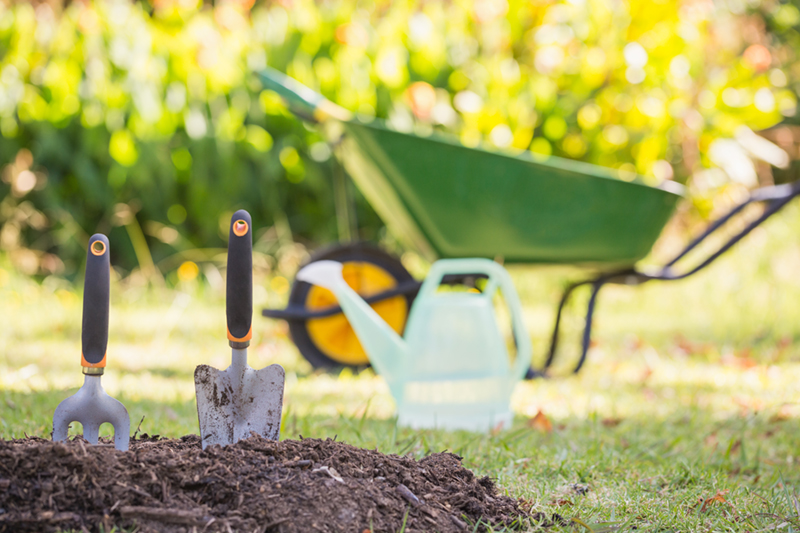Spring fever got you dreaming of lush gardens and sunshine? Despite what you might see on TV, beautiful landscapes don’t happen overnight. Weeds will invade your beds and need to be pulled. The mulch will break down and require replacing. And your attention span will no doubt move on to shinier things long enough for your garden to fall into disrepair.
Your spring fever may be temporary, but if you get to know your garden's unique conditions and choose the right plants, you'll ensure that both the garden - and your enthusiasm for it - will last for a lifetime.
Invest in your soil
To get the dirt on your dirt, perform a soil test with your local agricultural extension office. This will tell you everything you need to know about what will grow there and how to improve it.
In the meantime, amend your soil with as much organic matter as possible - either by starting a compost pile or by adding bags of composted manure. This will give it a better texture, a diverse population of beneficial organisms, and more fertility.
If your soil is poorly drained, either grow plants that tolerate wet feet, or install a dry creek bed or French drain to prevent standing water.
Ditch the trash trees
With any luck, the trees that you plant today will be there for a long, long time. Keeping that in mind, don't grow things that you'll regret one day - like a messy silver maple that drops seeds all over the lawn, or a cypress that will eventually dwarf your house.
When choosing a tree or shrub for your garden, consider the eventual size, form, and habit. Avoid planting anything that has weak limbs or is susceptible to pests and blights, because tree removal is a costly and unnecessary expense.
Understand your garden's sunlight
Those little “full sun” and “part shade” icons are on the plant tag for a reason - too much sunlight will burn the foliage and compromise the plant's health, while too little will make it lanky and weak.
Choose plants that thrive in your conditions. A spot that receives eight or more hours of direct sunlight is a perfect place to grow vegetables, fruit trees, and most flowers. Part to full shade is ideal for growing plants like perennials, ferns, and small trees that are naturally found in the forest's understory.

If you have a shady yard but can't live without roses and tomatoes, consider hiring a professional arborist to remove trees or large limbs to get more sunlight.
Purchase plants with confidence
If it seems like everything you grow dies sooner or later, stop buying unhealthy plants. Inspect the foliage at the garden center and slip the plant out of its pot to check for firm, white, and healthy roots. The best place to buy healthy plants is at a local garden center, but otherwise, purchase them shortly after they've arrived on a shipment.
If you can't find the plant you're looking for, order seeds, bulbs, and plants online from reputable sellers like Burpee Seeds and Plants, Brent and Becky's Bulbs, and Plant Delights Nursery.
Plant for all four seasons
It's tempting to do all your plant shopping in spring, but those pretty blooms will soon fade away. To avoid 11 months of boredom, choose a variety of plants that offer interest at different times of the year.
Grow summer-blooming plants like canna, coneflowers, and guara to keep the show going until fall, when colorful foliage and fall bloomers like mums and goldenrod take over.
For winter interest, look to trees with interesting branch patterns and bark, as well as unusual cultivars of evergreens - like heuchera and abelia - or even architectural, hardy palms and succulents.
Divide and conquer
Here's a huge money-saving trick: Choose a perennial, bulb, or ornamental grass that can be propagated by division - one that you'd love to see growing all over your garden in a few years.
Plant several copies of that plant in your garden. After a couple of years, divide the plants by digging them up and slicing through the middle with a sharp spade. For best results, do this in spring when the weather is cool and the plant is actively growing.
Plant the divisions in the ground again, cover the space between the plants with mulch, and water them thoroughly to help them establish. Repeat these steps every two years, and you'll have not only a ton of free plants, but also a garden that looks cohesive and established.
Spring is a season of boundless energy and renewal - make sure to channel that springtime energy while you have it and turn it into a garden you’ll enjoy all year long!
Related:
No comments:
Post a Comment